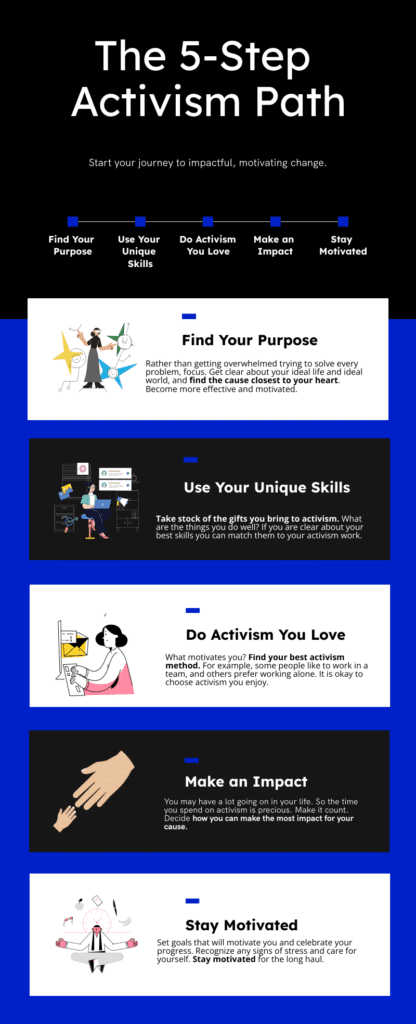How To Become an Activist:
Activism and Movements Defined
How To Become an Activist: Activism and Movements Defined
Welcome to your guide on how to become an activist! I’m so glad you are here and want to make a difference in your community. In this guide, I will show you how to become an activist using The 5-Step Activism Path. The path guides you to become a confident, impactful changemaker, using your unique skills to make a difference for the cause closest to your heart. Here, you will find information on activism, how activists define their activism, and how they go beyond traditional techniques to make creative change.
Contents
Define Your Activism, Your Unique Way of Making Change

Understanding Activism
Activism Defined
Activism is defined as influencing a person or group toward changing their awareness of and behavior about an issue. Volunteering is like activism but focuses on helping people rather than changing behavior. An activist might try to change littering laws while a volunteer clears litter from the community. Both are essential ways to make the world a better place.
Movements Defined
Movements are defined as larger-scale efforts that focus on societal issues. They are often composed of organizations and individuals working towards a common goal, such as civil rights, environmental justice, or feminism. Movements can span decades, evolving in response to changing social and political landscapes.
Grassroots Defined
Grassroots movements are characterized by a bottom-up approach. Unlike top-down initiatives often driven by established political entities or organizations, grassroots organizing relies on individuals working at a community level. These movements often begin with people seeking to change something that impacts their lives. This collective effort builds momentum around the cause. Because of the local focus, grassroots movements can create lasting change.
An example of a grassroots movement is NAMI, the National Alliance on Mental Illness.
“During the 1970s, family support groups scattered around the nation were seeking answers and treatments for their loved ones affected by mental illness. One group in California transformed a small gathering of families into an organization called Parents of Adult Schizophrenics, a nonprofit association that eventually changed its name to the Alliance for the Mentally Ill of San Mateo.
This local coming together helped spur a national movement. What started as a wave of frustrated parents concerned for their children grew into a tsunami of organized trailblazers advocating for more research, greater support, and broader public awareness called the National Alliance on Mental Illness: the nation’s largest grassroots mental health organization.” ~ NAMI Throughout the Years
Activism Movements and Grassroots Change
One of your decisions on the Activism Path is whether you want to be a solo activist or join up with others. Both approaches have advantages and disadvantages, and ultimately, what you choose should be based on what motivates you and works for your life. Some people make a profound impact through individual efforts, while others prefer to work in a team.
Activist Defined: Volunteer vs. Career Paths
When you decide to step off the sidelines and make a difference, one decision is whether you see activism as a career or a volunteer effort. Both paths are equally valid and impactful but often look different in practice.
A career in activism will probably mean a full-time job as a community organizer or nonprofit employee. The obvious advantage is compensation, but other good points include working with others, training and development, and impact.
Being a volunteer has advantages, too. Because it is highly flexible, you have many choices for crafting your changemaking to fit your life. There are numerous opportunities for changemaking, and you can use your unique skills to make a difference.
Both paths play a vital role in driving social change. The 5-Step Activism Path allows you to assess your motivation, time availability, and unique skills to determine which route best suits you.
Define Your Activism

Activism can take many forms. There’s no single right way to be an activist. The easy, research-based 5-Step Activism Path guides new and seasoned changemakers in crafting a personalized approach to activism. You will focus your passion on the cause closest to your heart, harness your unique skills, and make an impactful difference in the world.
The 5-Step Activism Path
Ultimately, defining your activism path is about finding meaning in your work. Whether you join a grassroots movement, work independently, pursue a career in activism, or volunteer your time, the 5-Step Activism Path helps you align your efforts with your passion and skills. Doing so can create a lasting impact.
1. Step 1: Find the cause closest to your heart. Focusing your passion helps you make activism a part of your life purpose and values. Instead of spreading yourself thin, develop your expertise for the cause dearest to you. You’ll be motivated and effective.
2. Step 2: Be clear about your unique skills. Think outside the box to match your unique skills to powerful social change. And consider what motivates you and build it into your activism. Activism isn’t just about marching. Today’s activists use art, public speaking, crafting, teaching, and the power of the pen to change the world. You can, too.
3. Step 3: Use an activism method you love. Make a difference by doing what you love. If protesting and lobbying are not your cup of tea, find a technique you enjoy and avoid stress and burnout.
4. Step 4: Make an impact on your cause. With so many needs in our world, jumping into activism without considering your impact is easy. But with one step, you can ensure your effort pays off in change. Find an activism opportunity that perfectly matches your skills, motivation, and life.
5. Step 5: Stay motivated for the long term. Set yourself up for success with goals and a stress management plan.
Learn more about the 5-Step Activism Path in this short video.
Get Started on Your 5-Step Activism Path
Where Do I Go From Here?
I Want To Customize My Journey
If you don’t have being an activist on your radar, learn more about how activism can change you and the world for the better. Start here: Me? An Activist?
If you are ready to get started but need tools and resources, start here: I’m ready. Where do I start?
If you have been making change but need help with burnout or effectiveness, start here: I want to be more motivated and effective.
I Want Resources To Guide My Journey
Explore Activism Books
The Happy Activist: Journey the 5-Step Activism Path to Focus Your Passion and Change the World
The 5-Step Activism Path Workbook: Your Guide From Passion To Action
Make a Difference with Mental Health Activism
To get the latest activism news, coupons, and links to popular blog posts, sign up for the Newsletter.
I’m Not Sure I Can Become An Activist
Still not sold on becoming an activist? Here are things people on the sidelines tell me. Find the surprising answers.

2. “One person cannot make a difference.”
3. “Those causes don’t concern me.”
4. “I could never be an activist,” or “I don’t know enough,” or “I don’t have activism skills.”
5. “I don’t know how to get started.”
7. “I do not want to protest.”
8. “I know there are issues, but I’m afraid.”
Want an easier way to follow the Activism Path?
While Life At The Intersection offers a great starting point for becoming an activist, using The Happy Activist: Journey the 5-Step Activism Path to Focus Your Passion and Change the World makes finding your perfect activism opportunity much easier. With in-depth material, hands-on exercises, and a companion workbook, you'll find the tools you need.
Get Your Copy Of The Happy ActivistFollow the 5-Step Activism Path
One of your decisions on the Activism Path is whether you want to be a solo activist or join up with others. Both approaches have advantages and disadvantages, and ultimately, what you choose should be based on what motivates you and works for your life. Some people make a profound impact through individual efforts, while others prefer to work in a team.






